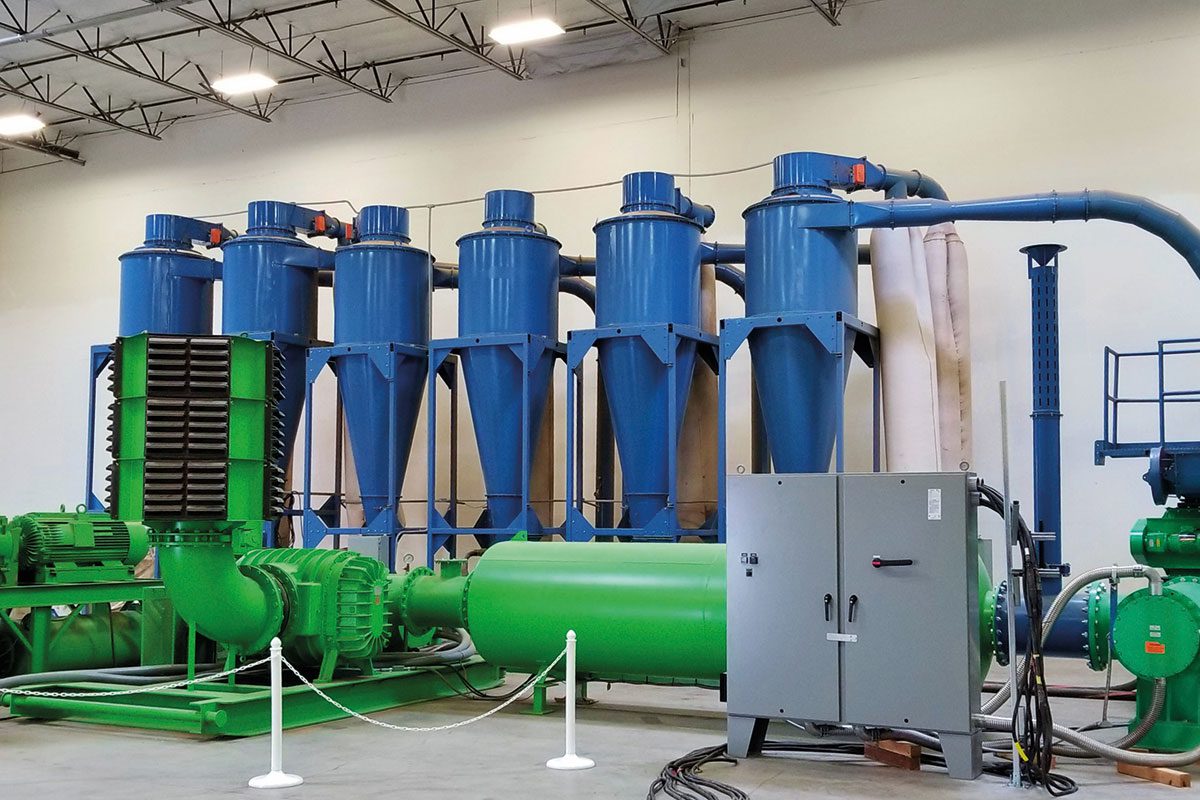Those in need of a quick and efficient way of removing moisture from biosolids and post-AD sludge will find much to intrigue them in a seemingly unique, aerodynamic pulverisation dryer called ‘Dryclone®’. Envirotec spoke to Pete Mulvany, CEO of REC (Recycling Equipment Company of Canada Inc.), UK exclusive distributor, for a better idea of what it does

It’s the sheer violence of the aerodynamic impaction process that is a particular eye-opener with Dryclone, and appears to account for its many apparent advantages over conventional drying systems.
Huge quantities of ambient air are drawn into the Dryclone by large PD blowers and accelerated to over 640 km/hour in an aerodynamically structured flow that’s continuously managed throughout the system. Wet materials are fed into this airstream and aerodynamically pulverized, causing both physical and evaporative removal of moisture.
The managed high-speed airflow continues within each of the blue, turret-like structures shown in the image above – the eponymous ‘Dryclone’ unit which gives its name to the product (although there will generally be several of these units working in parallel in a single Dryclone installation). The incoming air is also warmed by the natural heat of compression in the blowers.
Moisture extraction
The structured airstream creates a boundary layer and draws incoming materials towards the centre, where it is impacted with sufficient ferocity to shear open the cell structures of the material.
Any moisture is carried away by the airstream – which itself becomes ‘super-saturated’ with moisture – and transported to the top of each Dryclone, passing through a patented acceleration and separation system before it is released into the atmosphere, typically through a baghouse filtration system.
There will be up to eight of these Dryclones connected in series – subjecting any incoming waste to a succession of stages like the one just described, “continuously refining the removal of moisture”, as Mulvany explains, and smashing the feedstock material into ever smaller bits. Second and third blowers each introduce more warmed dry air ahead of the pipe elbows to maintain the structured airflow, prevent wear, and replace the air exiting at the tops of the cones.
Dryclone’s reliance on fast-moving air seems to be the key to its apparent advantages over conventional thermal drying systems. It means there are no moving parts in the material’s path through the Dryclone. It appears less a mechanical innovation than one that draws on expertise from aerodynamic engineering.
The non-reliance on gas burners is also deemed a boon as the latter often present permitting issues, and theoretical risks (fire and so on), as well as maintenance and emissions-handling issues.
Most dryers are also not so efficient at drying large amounts of material, and the end result is more of a “baked Alaska” as Mulvany puts it – dry on the outside with some residual moisture within – while with Dryclone, seemingly, bound moisture inside cell structures can be removed.
Dryclone can handle any wet, semi-solid biomass
According to Mulvany, Dryclone can handle any wet, semi-solid biomass, including food and green waste, municipal biosolids, food waste and more. The moisture content in many feedstocks is a headache as it makes them heavy and cumbersome to transport – so its removal is a priority.
Sludge is one application area. Users will often be seeking either to turn sludge into a nutrient-rich end product for use in fertilizers, or an energy-rich product with moisture content consistently low enough that it can be added to SRF. With there being signs of a crackdown against the land application of sewage sludge, Mulvany expects this segment to grow significantly.
Optimising waste-to-energy
Waste-to-energy also seems an important application area, and the sheer violence of the aerodynamic impaction process of the machine – with its ability to shear open cell structures and remove internal moisture – is a big selling point when producing waste suitable for gasification or pyrolysis, where any moisture is a serious headache, and can lead to air pollution (caused by the additional oxygen released from water during these high-temperature processes).
Also, the fact that the system produces a highly homogeneous material with a consistent energy density, is deemed a big plus here.
Similarly, says REC, Dryclone can be used with material intended for conventional incinerators, and lets them achieve significant improvements in energy efficiency, while reducing emissions.
Mulvany points to various apparent low-hassle aspects to using the system, such as the fact that no technical adjustments are needed when switching feedstock material, and Dryclone’s self-cleaning action minimizes cross-contamination.
A standard configuration – called ‘Dryclone TLX’ – can process up to 18 metric tons per hour, earning a fast payback on the equipment says REC – even faster when the machine is used to produce an energy-dense renewable fuel source.
The system is said to have a modular construction and different configurations are possible, catering for situations requiring less throughput, for example, or extra-high moisture content.
The lack of moving parts seems to be a boon from a maintenance point of view. And the seemingly highly structured nature of the airstream means there is a boundary layer that prevents materials from touching the walls of the unit, which don’t wear out from usage.
The machine can even handle glass, which is useful when Dryclone is used to dry post-AD sludge and MSW. Normally residual glass is a headache with the latter and can cause equipment damage, but if it’s processed by the Dryclone then any glass is aerodynamically pulverized into a sand, with rounded (rather than sharp) particles.
Another interesting aspect of the system is the innovative licensing model offered by the manufacturer RCI. This so it seems “protects every Dryclone customer’s investment by location and feedstock, as well as creating opportunities for early adopters to acquire exclusivity in larger territories to lock in the competitive advantage that Dryclone delivers.”







